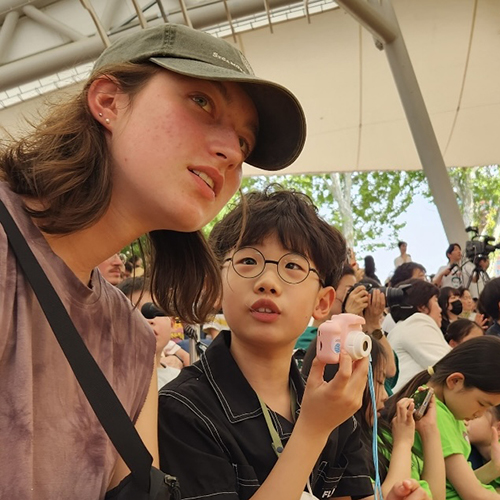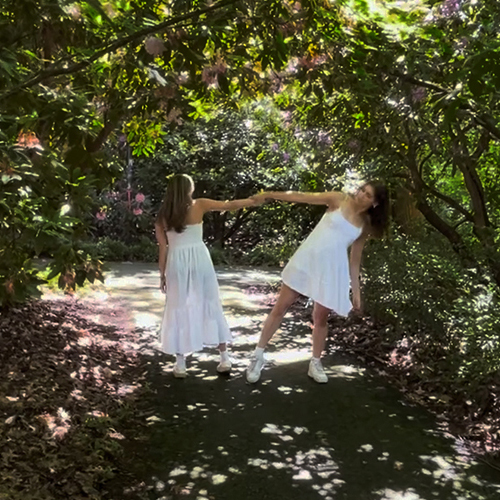Next time you watch the Huskies do battle on the football field, imagine the cheering crowd clothed in togas. While football may seem modern and quintessentially American, the sport is reminiscent of gladiatorial battles held in packed arenas during the Roman Empire, says Sarah Stroup, associate professor of classics.
Stroup discusses football and other connections between ancient and contemporary athletics in CLAS 324: War Games, a course offered by the Department of Classics. The class delves into the political and social forces at work in ancient Greece and Rome, demonstrating how sports played a societal role that went far beyond entertainment.

“One of the things I love about this course is that the content is accessible,” says Stroup, who estimates that about a third of the enrolled students are athletes. “Athletics is something that all students can recognize. The idea of spectacle is something they all can understand. I use that to get them thinking at a deep level about complex issues of civic identity both in antiquity and the present day.”
The topic seems tailor-made for Stroup. As a graduate student at UC-Berkeley, she spent two seasons excavating at Nemea, one of four sites of the Panhellenic games in ancient Greece. Leading the excavation was UC-Berkeley professor Steve Miller, an expert in ancient athletics, whom Stroup has since tapped for advice in developing her course.
Stroup explains that ancient Greeks saw athletics as an integral part of a young man’s education, along with philosophy, rhetoric, mathematics, and music. “Sports were implicated in every part of society,” she says. “They were seen as an important aspect of being a citizen.”

It was in this environment that the Olympic games were introduced in 776 BC. They were designed to mimic military training, with participants racing in armor—and nothing else. People from all over Greece, from every social class, came to compete. “There was an intense focus on fairness,” says Stroup. “It was a highly socially elevated and respected event.”
The tradition continued for more than 1,000 years, until Christian emperor Theodosius I, the last emperor to rule both the eastern and western halves of the Roman Empire, nixed the games. His beef: the event sites were sanctuaries for Greek gods.
The Olympics were resurrected about 1,500 years later, when a rise in Romanticism and Neoclassicism in Europe led to a fascination with antiquity. Stroup discusses the rise of the modern Olympics in class, noting similarities and differences from its ancient counterpart.
“In the ancient games, there was no element of nationalism in the modern sense,” Stroup explains. “And there was only one winner in each event—no silver or bronze medals. In fact there were no medals at all, no lasting symbol of victory. Today we love winners. We want everyone to be a winner. And the games have become heavily politicized and violence has intruded. That’s a major difference.”
Athletics is something that all students can recognize. The idea of spectacle is something they all can understand. I use that to get them thinking at a deep level about complex issues of civic identity both in antiquity and the present day.
Those changes seem minor, however, when compared with the tenor of sports competitions in ancient Rome. “Romans had games, but they didn’t enjoy Greek-style games,” says Stroup. “They had a complicated relationship with the Greeks. I think of it like a kid-brother relationship.”
While Greek games encouraged participation, Roman games were about observing rather than participating. The athletes were slaves, forced to compete in bloody spectacles that often led to injury or death. “In class, we talk about spectacle and the Roman addiction to violence, which pitted slaves against other slaves they knew and trained with,” says Stroup. “Then we move into a discussion of the American addiction to violence and violent sport. It’s a very tricky conversation.”
The earliest gladiatorial events were small affairs held by families using prisoners of war. The state began organizing larger-scale events in 46 BC, with the aim of controlling the public. “Life in the Empire was really rough for people,” says Stroup. “Rome could barely keep its citizens fed. This was a way of keeping people appeased and displaying Roman power and potential violence. Citizens watching the almost incomprehensible violence could think, ‘At least that’s not me.’”

The events were tremendously popular, with spectators filling Rome’s Colosseum and other venues across the Empire. “The Colosseum is just one of 250 amphitheaters that still remain,” says Stroup. “France, Italy, Tunisia, Spain, Turkey, Croatia… these events happened all over the Roman Empire. And it wasn’t once in a while. Events could go on for 100 days with thousands of pairs of gladiators.”
Despite their popularity, the events also had vocal critics, including philosopher Seneca and Christian bishop Saint Augustine, both of whom wrote at length about how gladiatorial events dehumanized not only the gladiators but also the spectators. Stroup has her students read these essays and other original source materials.
As students become engrossed in philosophical debates dating back to the Roman Empire, they discover that classics, a field sometimes pegged as stodgy and inaccessible, is anything but. Many students, once introduced to the discipline, decide to pursue it further.
“A lot of times, students will happen into a classics course and then it opens this world that previously seemed so out of touch to them,” says Stroup. “What classicists study can sometimes seem inaccessible, but the fact is, it is accessible and has tremendous value. It can be a great way to have important conversations about the past and the present.”
More Stories

Democracy by the Numbers
Mathematics and Democracy, an undergraduate mathematics course, explores the role of math in many aspects of democracy, from elections to proportional representation.

Finding Family in Korea Through Language & Plants
Through her love of languages and plants — and some serendipity — UW junior Katie Ruesink connected with a Korean family while studying in Seoul.

Dancing Across Campus
For the dance course "Activating Space," students danced in public spaces across the University of Washington's Seattle campus this spring.